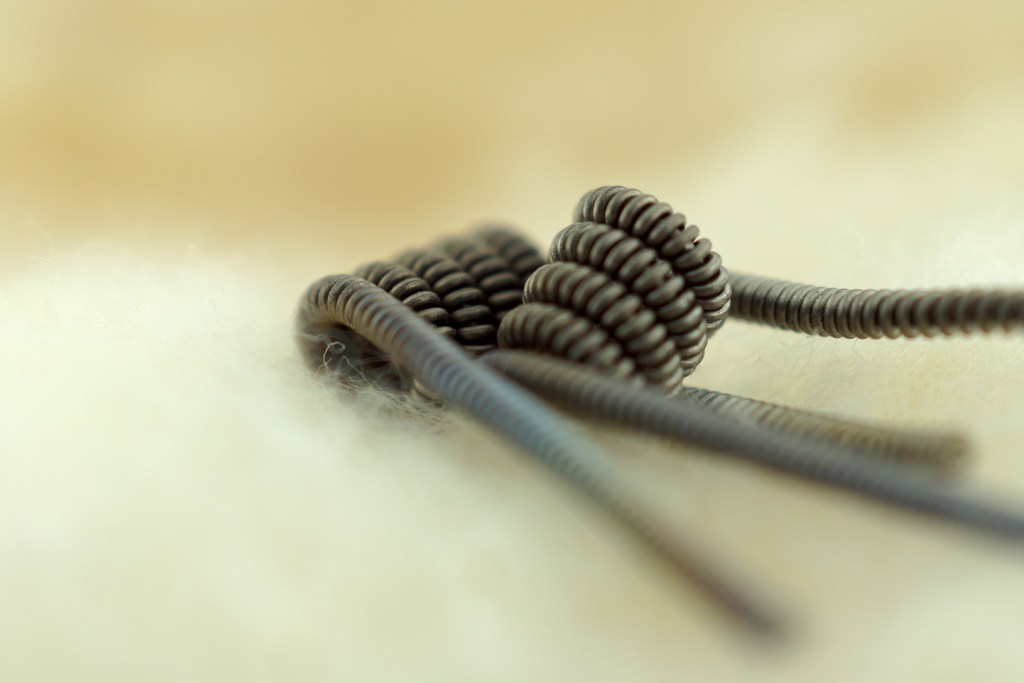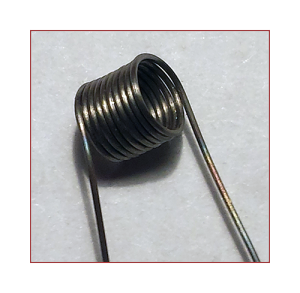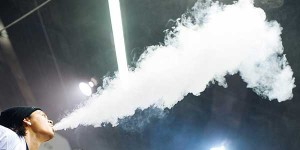The Art of Dripping 2015

Today, dripping has become a much larger segment of the vape community than it was in years past. Evidence of that can be seen everywhere but most apparent is the huge number of new, advanced dripping atomizers, Japanese organic cotton wicking is all the rage, and better and more varied wire for wrapping coils. Prepackaged coil building kits are also being sold in bigger numbers.
Words or Phrases used in this article:
What is ‘Dripping’ in 2015?
Simply put, dripping is vaping the hard way. For ‘vaping’ to be considered ‘the dripping method” a vaper must apply (mostly) low-nicotine e-liquid directly to the wicking material, today that usually means organic cotton (read about other materials here), in small amounts, fire it up with the fire button then immediately breathed in by way of a ‘lung hit‘. A ‘lung hit‘ occurs when you breathe in the vapor directly to the lungs, in a single step, allowing you to fill your lungs with vapor without a layover in your mouth.
For vapers the two methods of breathing in vapor are; the two-step process of breathing in vapor to fill your mouth and then another inhalation to take the vapor into the lungs. Most people who vape use this method. The other method, the ‘lung hit‘, bypasses the first step. I use to use the two-step process, but ever since I started using the new Kanger SubTank (which I’m obessed with!) I have switched over to the ‘lung hit’ method which I love. It creates an all around better vaping experience. If you haven’t tried it, I recommend that you do.
• Helpful Link: Building Your First Coil Guide
Dripping Atomizers
I’m going to be overly cautious here while talking about today’s atomizers because in another two years things might look completely different and I’d prefer this piece to remain relevant for as long as possible.
While you can still “drip” with a simple 510 cartomizer by pulling out the polyfill material and burning off the remnants inside by attaching it to a vaporizers and squeezing off the firing button for a couple of seconds, there are many more advanced drippers that require complex coils and precise measuremetns of the ohms ratings, as well as the most accurate mechanical mod or advanced vaporizer to provide the precise amount of power (wattage) to the atomizer. That said, ‘dripping’ in the purest sense requires nothign more than applying eliquid idrectly onto the coils/wicks, furnishing power to the coils/wicks and breathing in the vapor. The “art” of dripping is much more complicated, as we will see. But first let’s discuss the explosion of sub-ohm atomizers that hit big in 2014 and what confusion it can bring to the art of dripping.
Sub-Ohm Vaping in 2015
 The biggest phenomenon of 2014, in our community, has to be the sudden popularity of ‘sub-ohm’ vaping. ‘Sub-ohm’ means any coil rated at less than 1.1-1.0 ohms.
The biggest phenomenon of 2014, in our community, has to be the sudden popularity of ‘sub-ohm’ vaping. ‘Sub-ohm’ means any coil rated at less than 1.1-1.0 ohms.
Getting down to resistances of 1 ohm and lower provide warmer, thicker vapor, but not necessarily more flavor, when used correctly. In fact the whole idea of dripping was to increase both vapor AND flavor, and building coils that rate between 1.2-1.6 ohm is primed for both flavor and vapor. However, you can also get extremely good flavor as low as 0.5 ohms using the right eliquid and the right atomizer.
There are plenty of argument out in the vape community that support the position that ‘lower than half an ohm’ of resistance can still provide great flavor, but I’ve been in the territory and I can attest to the fact that while the flavor is certainly ‘good’ down in the 0.3 ohm territory its not as good as 0.5 ohm and up, no matter what modern day e-liquid you use. It just not.
Sub-ohm coils used to live only in the world of RBA’s and Drippers, but are now common in several glassomizers. A glassomizer is an e-liquid delivery device made of Pyrex glass or metal, or both, and contains a pre-built, self-contained atomizer, or coil head, and provide ample capacity for eliquid. It began with Kanger in mid-2104 when they introduced 0.8 ohm coils head replacements for most of their clearomizer/glassomizer line, including the ProTanks and Aerotanks.
Sub-Ohm Premade Coils
While vaping with glassomizers with coil heads rated at less than 1 ohm came into existence in 2014, it was the glassomizers introduced towards the end of 2014; the two very popular devices by both Aspire (the Aspire Atlantis) and by Kanger (the Sub Tank). Neither of these two glassomizers are dripping devices, of course, showing clearly that sub-ohm coils and coil heads do no automatically lead to dripping.
• Helpful Link: Ultimate Guide For Rebuildable Atomizers
Modern Tanks As Drippers
Using the RBA component as a dripper goes like this: The RBA component “deck” is smaller than most RDA decks, but the full size Subtank has a deck that can use dual coils, the Delta 2 RBA component uses a single, larger coil. By stringing strands of organic cotton through the coils, then applying several drops of eliquid directly to the cotton, and of course attaching the glass tank and top cap/drip tip it becomes an “enclosed” dripper. Sure, you can fill the tank up with eliquid for a long lasting RBA, but you can also drip with it by leaving the tank empty and just soaking the cotton. If you have some premade cotton strips handy you can go through several flavors of eliquid to find the ones you want to vape in larger capacity. It saves a lot of time and money by trying out these flavors first with the RBA component. Keep in mind that the coils that come attached to the RBA component, in both cases, are 1-ohm set ups.
Coil heads for these glassomizers mentioned above get as low as 0.5-ohms. At this resistance, certainly in the middle of sub-ohm territory, the Vaper (not vapor) could fill a tank with up to 6ML of eliquid, which provides a few hours of heavy vapor and incredible flavor without the need to build a coil. (Keep in mind that low-ohm, high wattage vaping uses up eliquid much faster than standard resistance coils vaped at 3.8-4.2v) I would go so far as to say that these glassomizers performed as well as many very good RBA’s when it came to flavor, and about 95% as well in vapor production over the best of RBA’s.
These new glassomizers are best used with advanced vaporizers instead of mechanical mods because with an advanced vaporizer you can adjust the amount of power (wattage) or voltage reaching the coils. Mechanical mods output a steady amount of power that does not change (in a perfect world), and building coils for mech mods requires knowing a little about that, as well as a lot about “ohms law”. Lastly, while you can use an advanced vaporizer with a dripping atomizer, as mentioned above with the new tanks, the performance varies greatly from device to device.
When it comes to going lower than 0.5-ohms you come out of the glassomizer (in 2014 anyway) and head back into the RBA and RDA world, and often enough, a mechanical mod.
Cloud Chasing and Dripping
 I have vaping friends that compete in cloud-chasing competitions all the time in Florida and Massachusetts. Cloud Chasing is the new sport in which vapers try to see how much vapor they can produce with a single lung hit. The more vapor that is produced, called “clouds”, the better.
I have vaping friends that compete in cloud-chasing competitions all the time in Florida and Massachusetts. Cloud Chasing is the new sport in which vapers try to see how much vapor they can produce with a single lung hit. The more vapor that is produced, called “clouds”, the better.
Vapers who are ‘into’ this sport are continually chasing that vapor ‘dragon’ by attempting to build coils at lower and lower resistances, which will provide more and more vapor…in combination with the ‘right’ eliquid of course. This competition level vaping can’t happen with today’s glassomizers, though it get’s awfully close with the Kanger Sub Tank RBA component, and the Delta 2’s RBA component. Still, the rebuildable component coils in these tanks are just shy of RBA and RDA performance in dedicated rebuildable devices, so they are not usually accepted in cloud chasing competitions.
The Art of Dripping Defined
“Combining the right atomizer, the right coil gauge and material, the right wicking, the right eliquid, the right mod, the right nicotine strength, and the right lung hit is where the art of dripping comes in”. Lets discuss each part of that system.
The Right Atomizer
There are probably in excess of a hundred rebuildable dripping atomizers (RDA) on the market today. They range from $20 to more than $200. They differ with RBA’s, or rebuildable atomizers, only in the sense that an RBA atomizer has a tank capacity that will hold larger amounts of eliquid and a true dripping atomizer does not.
Without wanting to get complicated for the sake of being complicated I’ll just say that the more money you spend on an RDA doesn’t mean you’ll necessarily get better performance. There as plenty of dripping atomizers that sell for less than $40 that do a great job, while there are more expensive ones that perform at the same level, or worse, than the $40 devices. There are also some very expensive RDA’s that outperform all the rest. In my dripping history I started with a stripped out 510 Boge cartomizer, moved to the HH357’s, (a cartomizer made for dripping), and then onto dedicated dripping atomizers.
When it comes time to choose the right RDA for you, here are some questions you should ask yourself before buying:
1. What is my budget? (Don’t overspend and don’t underspend. Know your budget.)
2. How often do I plan to drip? Is my dripper my primary device for vaping, or it is my sport, or hobby?
3. Will I want to build single coil, double, or quad coils now or in the future?
4. How much acces do I need the deck and posts? Are your fingeres bigger than normal, do you have arthritis, or can you easily reach even the most difficult, or tighest places on the deck to thread the psots properly?
The Right Coil & Wicking
You won’t know the right coil for you in the first month or so of building coils for dripping. Wires come in many gauges and wicking is just as varied. The gauge of the wire will depend on the resistance you want to build, so buy a few different ones because there will be days where you’ll want to build a 1.5-1.6-ohm coil (or higher) and days where you’ll want to build a 0.5-ohm coil (or lower).
I would say that when it comes to dripping atomizers build with the best wire that will help you reach the ohms you want to reach, but use cotton as your wicking. Japanese organic cotton is all the rage right now for a reason, but any pure, unadulterated cotton will work, though I do like my Japanese organic cotton.
In the end, building coils for your dripper or your tank is basically the same so if you are just starting out wrap as many coils as you afford to wrap in order to get proficient at it, and always test the resistance before you vape with it.
Recently we posted an article reviewing some of the most popular and what we think are some of the best materials to use for wicking. Click here to read this article.
The Right Mod or APV
There is a reason some mechanicals cost a fortune, but its often not the performance, it’s the material or the artwork, or simply the reputation. I get more than decent performance from a SMOK Magneto ($40) as I do most more expensive mechanicals when using RBA’s, but not so great performance when dripping.
Some mechanical mods, or mech mods, do cost a lot more because of the precise machining of the components. The silky smooth threading, the silver, gold, copper pins, the perfect firing button and switch; the flexible and adjustable pin, these can all make a big difference. The voltage drop off can virtually disappear with good, well-made, mechanical mod using the right metal at the contacts.
Unlike many other drippers I actually prefer to use an advanced vaporizer, or APV. The obvious reasons begin with safety issues. Mechanicals, no matter how well built they are, are unprotected devices. The likelihood of one blowing up is miniscule, but combine a badly built coil with a faulty mech mod and suddenly it’s not so far-fetched. An APV has many safety features designed to ward off the chances of getting hurt, or allowing a dumb mistake to take a toll on you.
Other reasons why I prefer APV’s to mechanicals include being able to maximize the performance of my coils by adjusting the power coming to it, the information I can see, and how I can manipulate that information on the LED display, and lastly, the choices I have in design and cost.
I have had some incredible dripping sessions with an eVic Supreme, an IPV Mini, A Sigelei 50W and 100W, and others. Most devices now offer both wattage (power) and voltage control, and for dripping nothing makes more sense than variable wattage, it goes to the very heart of successful dripping.
The Right E-Liquid
This is arguably the newest conundrum in the art of dripping. 2014 marks the year of specialized eliquids. High Performance eliquids are eliquids that are formulated for dripping. High VG or no PG recipes provide enormous clouds of vapor. People that compete in cloud chasing events use this type of eliquid.
But, there is a problem with some of these high performance eliquids. VG, vegetable glycerin, is not the best flavor carrier. Full flavored eliquids are best made with at least some PG, (Propylene Glycol), which is the flavor carrier component. It seems to me that only the best eliquid brands know how to successfully create an eliquid that delivers maximum vapor and flavor without using PG.
I can’t tell you what the best brands are for use in drippers, that’s a completely subjective topic and it depends on what you want to get from dripping. Just keep in mind that dripping in the “old” days was equally divided with flavor and vapor in mind. Today, vapor production seems to have taken the lead.
The Right Nicotine Level
Whatever your nicotine strength is when you are vaping with mainstream atomizers you will want to cut down the nicotine strength for dripping. Sub-ohm dripping, and normal vaping, will cause you to cut down the nicotine even more than dripping with 1.6-1.8-ohm coils. The reason is simple; sub-ohm and lo-ohm coils utilize the eliquid more efficiently, and that includes the nicotine in the juice. Not only will vapor production increase like crazy, but so will your throat hit due to more heat in the vapor, and the natural throat hit characteristics of nicotine. You body will absorb the nicotine faster because the atomizer is vaporizing it more efficiently.
Earlier this year I would ‘vape’ with 18mg nicotine while using mainstream tanks and glassomizers with coils ranging from a high of 2.1-ohm to a low of 1.6-ohm. During the same time I would drop to 6mg for dripping onto coils and cotton, or in any RBA, whether dripping was involved or not. For the past 4 months I’ve been vaping (my non-reviewing, personal vaping) 12mg nicotine in my eliquid when using mainstream vape gear and for dripping I will use an eliquid with 3mg nicotine. The absorption rate, and the throat hit are about equal at these levels. Just don’t think that the less nicotine you’re vaping the less of a nicotine addiction you’ll have. Your body is still utilizing roughly the same amount of nicotine in the bloodstream.
• Helpful Link: 10 Facts About Nicotine In E-Cigarettes All Users Should Know
Combining All Elements Into The Art of The Drip
It is only through experience with all the above elements of dripping will you develop a ‘feel’ for what it will take to create the best drip. You’ll learn what coil and what resistances work best for you with certain eliquids. You’ll learn which Dripper to use, which wire and wicking to use, and you’ll develop it all into an art form. That is the Art of Dripping.
After several months with drippers and high performance eliquids you’ll be designing certain “vapes” for certain times of the day, or certain vape experiences during the day. You’ll know what you want in a vape for, say, watching an action movie or a comedy, or for lying in bed or playing poker (I’m serious). In other words, the art of the drip will become second nature with enough practice and enough ‘thought’. Ask yourself questions when you’re about to build a coil, or choosing the right dripper;
• What am I in the mood for?
• Do I want more clouds today or more flavor?
• Which gauge works for what I want to accomplish today?
• How much cotton will create the vape I’m looking for today?
The Wrap Up
What was once a variation of vaping that provided the best flavor for eliquid has become predominately a method for creating the biggest clouds of vapor. Dripping was once a method for a better vape, today it’s a sport, with competitions, trophies, and awards. And that’s not a bad thing, as long as it’s done safely.
The very idea of a 150w device like the IPV v3 and coils rated a 0.1-ohms was unthinkable to me just a year ago. Today I see more and more drippers seeking out the lowest possible ohms they can build, and providing the most wattage they can push. While I enjoy watching competitions and videos of these huge cloud makers I’m not someone willing to go that low, or take that many risks.
Those huge clouds you see at conventions or on YouTube possess less flavor and more vapor. It’s tradeoff, and it can sometimes be an awesome tradeoff. There’s nothing quite like watching enough vapor leave your mouth to block all the light from a room. That alone can be enough sometimes, just be careful with it…
Drip safely, and have fun.
Credit: Tom McBride and Tiffany Gambino
